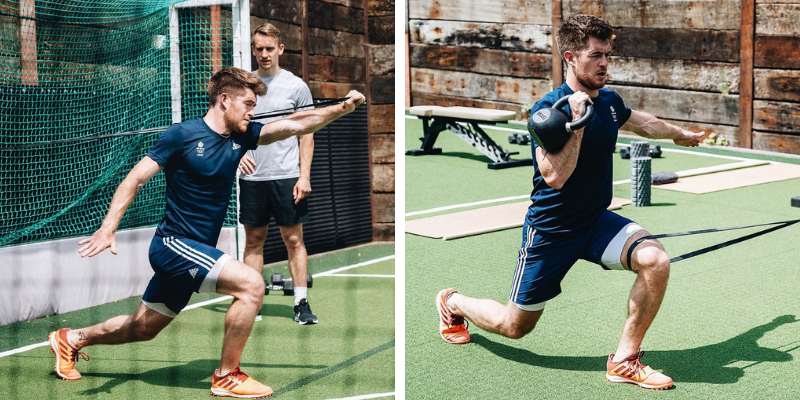So, what is prehabilitation?
“Training to train or rather training to withstand training,” says athletics Track & Field Coach John Shepherd, another term for it is ‘preconditioning.’

“It is effective in reducing injury and therefore, indirectly, improves performance,” explains Shepherd. “For many track and field athletes, days and weeks of training can be lost through injuries. I believe that after a prolonged period of prehabilitation training, coupled with a systematic and progressive training plan, that many common injuries can be avoided, and almost ‘prehabbed out.’”

The prehabilitation process
So, what does ‘prehabilitation’ actually involve? To explain it simply, many coaches, physiotherapists and indeed medical professionals, believe that to avoid injury you need to condition your body, so it is ready to best withstand the forces it is subject to when performing a certain sport.
Prehabilitation is body-part specific and whole-body targeted exercise – it isn’t the same as normal training. In some cases prehabilitation exercises can be quite subtle and appear harder than they look. This is because they are designed to really isolate muscles and joints, often in a specific way and over a specific range of movement.

Shepherd believes that prehabilitation exercises can be broken down into three key areas:
- Balance work
- Conditioning the body in a number of different planes
- Utilising different muscular actions

-
Balance work
“Balance is a key aspect of prehabilitation,” explains coach Shepherd. “Being able to control your body through a single leg stance is crucial for any track and field athlete. Dynamic stance exercises are another great way to prehab. Balance work is vital in any prehabilitation programme.”

-
Different planes of movement
He goes on to warn that athletes shouldn’t just train with exercises that cover the plane of movement of their event. He provides an example: “For the events I coach, sprinting and long jumping are obviously linear, however, the body still has to be able to control lateral and rotational forces."
"These will occur on the foot-strike of the long jump take-off board or on the track when sprinting. Without proper lateral control, huge unwanted forces will be sent through the knee and ankle which can lead to injury and reduce performance effectiveness.”

-
Different muscular actions
Utilising different muscular actions when doing prehab exercises is the third key area of a prehabilitation programme. Shepherd gives more detail: “When talking about different muscular actions, I specifically mean eccentric muscular actions – which are the lengthening/braking ones.
“Most hamstring strains occur when the muscle lengthens and then shortens to arrest the swing phase of the leg during sprinting. If an athlete includes specific eccentric exercises in their prehabilitation programme, such as leg cycling drills, they will be building up protection against such strains.”

The above are the three pillars of prehabilitation. However, Shepherd stresses there are other ways to help with prehabilitation.
Weight and resistance training
Shepherd believes that weight training and other resistance exercises on a more general level are important for prehabilitation:
“Weight and resistance training can strengthen soft tissue and this in itself is valuable for withstanding injury. You can also train your tendons more specifically with certain ranges of movements. Thus, you can utilise specific, more mainstream training modalities, to have more of a prehab role.”

Bioelectrical support
Bioelectrical therapy, such as NuroKor, can also play a part in complementing prehabilitation. Both the NuroKor mitouch and mibody can be used to help activate relevant muscle groups before a training session.
And for some athletes, they might choose to wear the mibody during a training session, as long as the level is tolerable and does not adversely affect their movement patterns.

Lamin Deen, Captain of the bobsleigh team, explains the different ways him and his teammates incorporate NuroKor to enhance their training regime on the go.
“Myself and the team, benefit massively from the NuroKor devices, the team wear the devices whilst working out not just after. We get the activation and it really gets the muscles firing.”
Mixing it in
When the benefits of prehabilitation are explained, it’s hard to understand why some athletes don’t partake in a prehab programme. Shepherd explains why there may be some resistance: “
Athletes often think that they are wasting valuable training time by focusing on balance and stability drills. They often want to go straight to the exercises they deem will improve their performance.”
He continues: “Obviously I'd say athletes are definitely not wasting their time doing prehabilitation. One of the ways you can help athletes feel that they are not doing this is to include prehab exercises in the warm-ups and in other parts of standard training sessions. For example, we include agility drills, which involve lateral and rotational movements, as a full part of a training session. This way you are always prehabbing and hopefully keeping those injuries away!”

All year round
Prehabilitation programmes can be used to help avoid a range of different injuries, but for track and field athletes in particular, Shepherd believes that prehabilitation can hugely help reduce the risk of hamstring strains, knee, back and Achilles tendon problems.

Shepherd warns that prehabilitation shouldn’t really be dipped in and out of, however, and should be a top priority throughout the athlete’s training and career. As he concludes:
“Prehabilitation is something that needs to be done in training all year around and not just at the start of training blocks. Full engagement with a prehab programme will reduce the chances of any unwanted and unnecessary injuries and help the athlete train to their maximum potential.” Staying #ready4more

Learn more about John Shepherd on his website or find training videos on John’s YouTube Channel
Click here to learn more about the NuroKor mibody and mitouch devices



